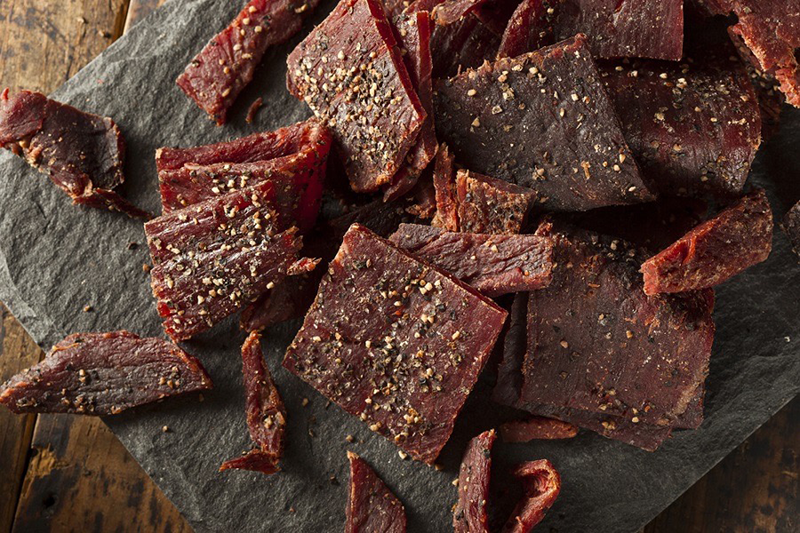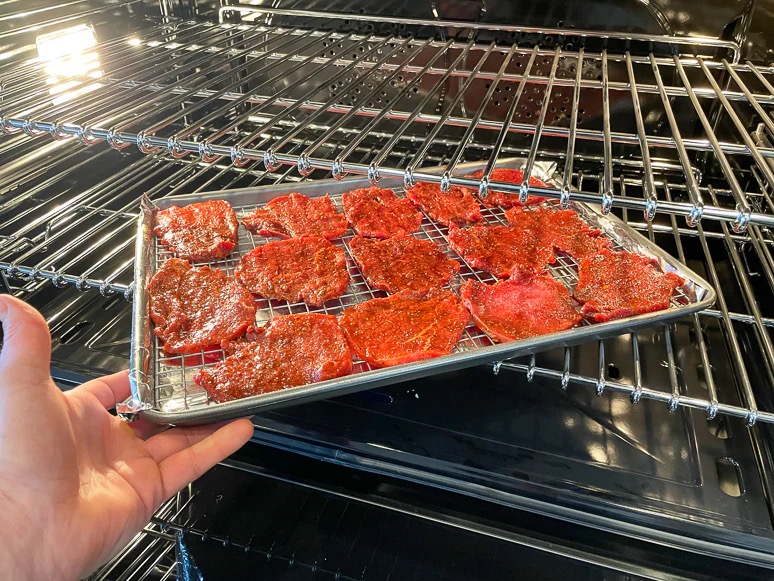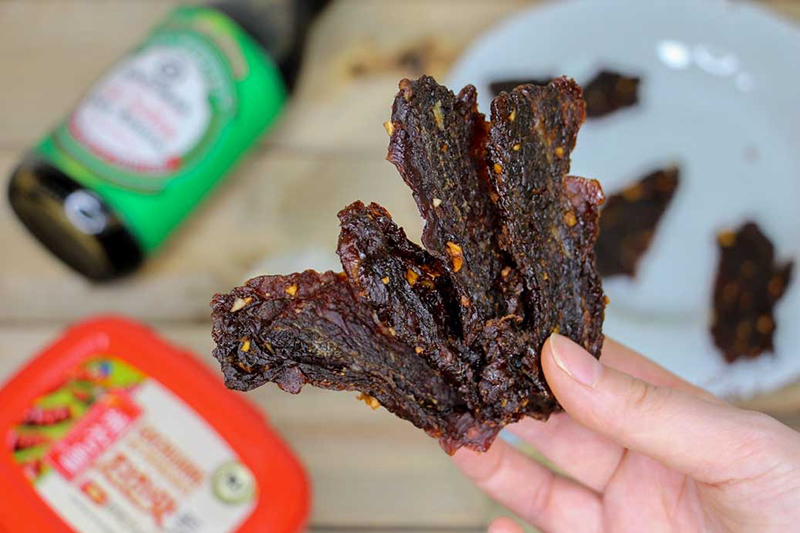
Content Menu
● The Benefits of Using a Food Dehydrator
● How to Make Beef Jerky in a Food Dehydrator
>> Ingredients
>> Equipment
>> Step-by-Step Instructions
● Tips for Perfect Jerky
● Understanding Drying Times and Conditions
● Common Mistakes to Avoid
● Health Benefits of Homemade Beef Jerky
● Conclusion
● FAQ
>> 1. Can I use any cut of beef for jerky?
>> 2. How long does it take to dehydrate beef jerky?
>> 3. Can I dehydrate other foods in my dehydrator?
>> 4. How should I store my homemade beef jerky?
>> 5. Is homemade jerky healthier than store-bought?
● Citations:
Making beef jerky at home is a rewarding and delicious endeavor, especially when using a food dehydrator. This article will guide you through the process of creating your own beef jerky, exploring the benefits of using a dehydrator, and answering common questions about this method.

The Benefits of Using a Food Dehydrator
A food dehydrator is an appliance designed to remove moisture from food, which helps preserve it and enhance flavors. Here are some key advantages of using a dehydrator for making beef jerky:
- Consistent Temperature Control: Dehydrators maintain a steady temperature, ensuring even drying without cooking the meat.
- Nutritional Retention: Unlike traditional cooking methods that may destroy nutrients, dehydrating retains more vitamins and minerals in the food.
- Versatility: Besides beef jerky, dehydrators can be used for fruits, vegetables, herbs, and even snacks like fruit leather.
- Cost-Effective: Making jerky at home is often cheaper than buying pre-packaged options, allowing you to experiment with flavors and cuts of meat.
How to Make Beef Jerky in a Food Dehydrator
Ingredients
To make delicious beef jerky, you will need:
- 2 pounds of lean beef (e.g., top round or flank steak)
- Marinade ingredients (examples below):
- 1/4 cup soy sauce
- 1/4 cup Worcestershire sauce
- 1 tablespoon brown sugar
- 1 teaspoon garlic powder
- 1 teaspoon onion powder
- Optional: red pepper flakes for heat
Equipment
- Food dehydrator
- Sharp knife
- Cutting board
- Mixing bowl or ziplock bag
- Paper towels

Step-by-Step Instructions
1. Prepare the Meat:
- Trim any visible fat from the beef as fat can spoil faster than lean meat.
- Place the meat in the freezer for about 1-2 hours until it is firm but not completely frozen. This makes it easier to slice.
2. Slice the Meat:
- Using a sharp knife, slice the beef against the grain into strips approximately 1/4 inch thick. For chewier jerky, slice with the grain.
3. Make the Marinade:
- In a mixing bowl or ziplock bag, combine all marinade ingredients. Mix well until the sugar dissolves.
4. Marinate the Meat:
- Add the sliced beef to the marinade, ensuring each piece is well-coated. Seal the bag or cover the bowl and refrigerate for at least 6 hours, preferably overnight for maximum flavor.
5. Prepare for Dehydration:
- After marinating, remove the beef strips from the marinade and pat them dry with paper towels to eliminate excess moisture.
6. Set Up Your Dehydrator:
- Preheat your dehydrator to 155°F (68°C). Arrange the beef strips on the dehydrator trays in a single layer without overlapping to allow for proper air circulation.
7. Dehydrate:
- Place the trays in the dehydrator and let them run for about 4 to 6 hours. Check periodically; jerky is done when it is dry but still flexible.
8. Cool and Store:
- Once finished, let the jerky cool completely before storing it in airtight containers or vacuum-sealed bags. Properly stored jerky can last for months.
Tips for Perfect Jerky
- Experiment with different marinades by adding spices or using different types of sauces to achieve unique flavors.
- For added smokiness without a smoker, consider incorporating liquid smoke into your marinade.
- Always ensure that your dehydrator is clean before use to avoid contamination.
Understanding Drying Times and Conditions
The drying time can vary based on several factors:
- Thickness of Meat: Thicker slices will take longer to dehydrate. Aim for uniform thickness around $$ \frac{1}{4} $$ inch.
- Humidity Levels: High humidity can increase drying times as moisture in the air slows down evaporation.
- Ambient Temperature: Warmer environments may speed up drying times while cooler temperatures may extend them.
Regularly check your jerky during dehydration, especially after three hours. The texture should be dry but still pliable; if it snaps when bent, it's over-dried.
Common Mistakes to Avoid
When making beef jerky, there are several common pitfalls that can affect quality:
- Using Fatty Cuts of Meat: Fat does not dehydrate well and can lead to rancidity. Always opt for lean cuts.
- Skipping Marination: Marinating not only adds flavor but also helps tenderize the meat.
- Overcrowding Trays: Ensure that pieces do not touch or overlap on trays; this allows proper airflow which is crucial for even drying.
Health Benefits of Homemade Beef Jerky
Homemade beef jerky offers several health benefits compared to store-bought versions:
- Control Over Ingredients: You can choose organic or grass-fed beef and avoid preservatives or artificial additives commonly found in commercial products.
- Lower Sodium Options: By adjusting marinade ingredients, you can create lower-sodium versions that suit your dietary needs.
- High Protein Snack: Beef jerky is an excellent source of protein, making it ideal for athletes or anyone needing a nutritious snack on-the-go.
Conclusion
Making beef jerky in a food dehydrator is not only simple but also allows you to customize flavors according to your preferences. With just a few ingredients and some patience, you can create delicious homemade jerky that rivals store-bought versions while retaining more nutrients and flavor.

FAQ
1. Can I use any cut of beef for jerky?
Yes, while lean cuts like top round or flank steak are recommended due to their lower fat content, you can use other cuts as long as they are trimmed of excess fat.
2. How long does it take to dehydrate beef jerky?
Typically, it takes between 4 to 6 hours at a temperature of around 155°F (68°C), but this can vary based on thickness and humidity levels.
3. Can I dehydrate other foods in my dehydrator?
Absolutely! Food dehydrators are versatile appliances that can be used for fruits, vegetables, herbs, and even yogurt.
4. How should I store my homemade beef jerky?
Store dried jerky in airtight containers or vacuum-sealed bags in a cool dark place; refrigeration can extend its shelf life even further.
5. Is homemade jerky healthier than store-bought?
Generally yes! Homemade jerky allows you to control ingredients and avoid preservatives often found in commercial products.
Citations:
[1] https://littlehousebigalaska.com/2022/01/beef-jerky-food-dehydrator.html
[2] https://peopleschoicebeefjerky.com/blogs/news/how-to-make-beef-jerky-in-a-dehydrator
[3] https://www.foxvalleyfoodie.com/homemade-beef-jerky/
[4] https://www.youtube.com/watch?v=Wj-xTmebJBQ
[5] https://thehouseandhomestead.com/homemade-beef-jerky/
[6] https://www.youtube.com/watch?v=GEakkNff6aY
[7] https://www.jerkyholic.com/how-to-make-beef-jerky-with-a-dehydrator/
[8] https://hiphipgourmet.com/recipe-for-beef-jerky-in-a-dehydrator/
[9] https://www.aromaco.com/recipes/best-beef-jerky/
[10] https://www.allrecipes.com/recipe/142948/docs-best-beef-jerky/












